In summer 1976 I read The Highland Clearances by John Prebble on the long trip north by train from a family holiday in Edinburgh. The memory is vivid as the journey took us past the statue of the Duke of Sutherland above Golspie, Sutherland. I recall feeling angry as I read how the tenants were compelled to contribute to this memorial to the man who had turned them from their lands. Equally vivid is the impact of the strath of Kildonan as the train chugged slowly through this cleared landscape. It was a place I wanted to visit.
Far too many years later, partly inspired by a UHI History student’s blog post about a field trip there, and on the best day of summer 2020, I finally visited Kildonan. Here’s a little about my day along with some background. Links to information about the Clearances in general at the end.
The Clearances Trail
Between 1807 and 1820, many of the inhabitants of Kildonan, tenants of the Duke and Duchess of Sutherland, were cleared from their homes to make way for sheep. The population of the parish fell from 1440 in 1801 to 257 in 1831.1New Statistical Account (1845), Kildonan, p147 https://stataccscot.edina.ac.uk/static/statacc/dist/viewer/nsa-vol15-Parish_record_for_Kildonan_in_the_county_of_Sutherland_in_volume_15_of_account_2/ Some settled in Helmsdale a village in Sutherland on the north east coast of Scotland, between Inverness and Wick. That’s where my visit began.
This map on the National Library of Scotland website will help you get your bearings.
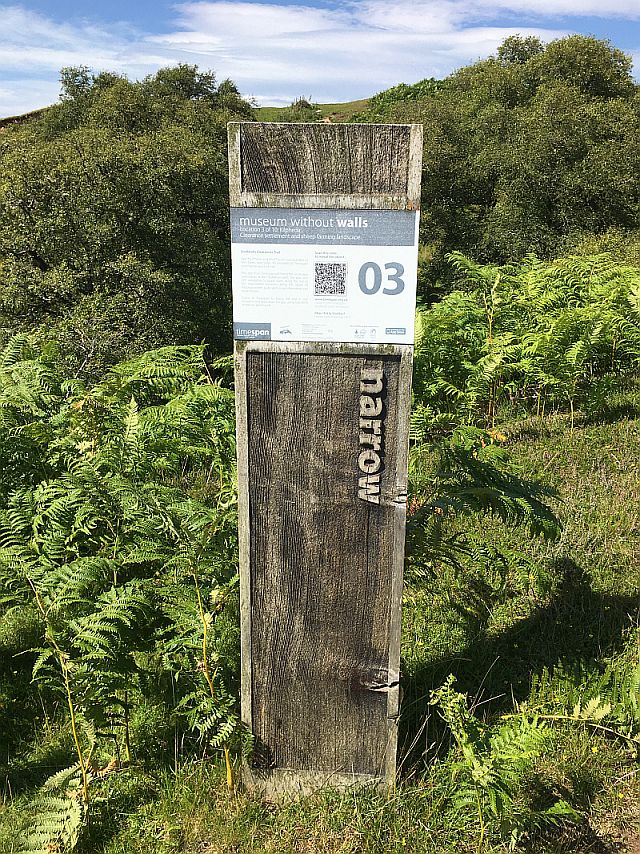
There are two things, apart from a good map, to help you find your way. The Museum without Walls app from the Timespan Museum in Helmsdale (iPhone or iPad only). I’d recommend this for background, whether or not you are actually visiting. Then there are information boards along the Clearances Trail itself with QR code links to the same information. (I think this is so but I did not try it out.)
After leaving Helmsdale on the A897 north of the river Helmsdale, Kilphedir and the Chorick settlement was my first stop. Apart from traces of houses, there is also the well preserved remains of a kiln used for drying grain. A good place for hiding illicit whisky stills it seems!

There is evidence of settlement over many centuries all along the strath of Kildonan, brochs, cultivated terraces etc. It’s the kind of environment where I would expect to see habitation and cultivation rather than emptiness apart from a few houses belonging to the estates.

Kildonan Church
Further along, we diverted to Kildonan church. This was the church for the whole parish which stretched from the coast at Helmsdale some nine miles away, right up to area around the Garvault Hotel (said to be the remotest in Britain) and the summit of Ben Griam Beag. The church at Helmsdale dates from 1838. In the graveyard are stones in memory of the Rev Alexander Sage and both his wives. He was minister at the time of the clearances and his son, Donald, wrote an account of those times, Memorabilia Domestica: parish life in the north of Scotland. More on Donald later.

There’s a reminder here too of the many who left Scotland entirely as a result of the clearances. And the success of their descendants.
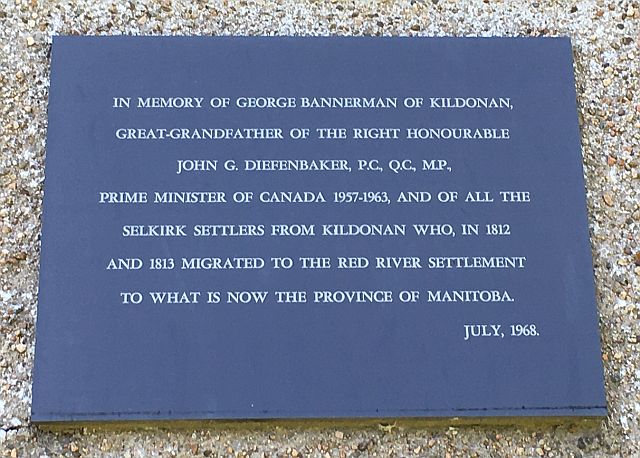
Kinbrace
At Kinbrace I left the A879 and took the B871, along the Bannock Burn (not THE Bannockburn) heading west to another site I was keen to see. But first a graveyard visit.
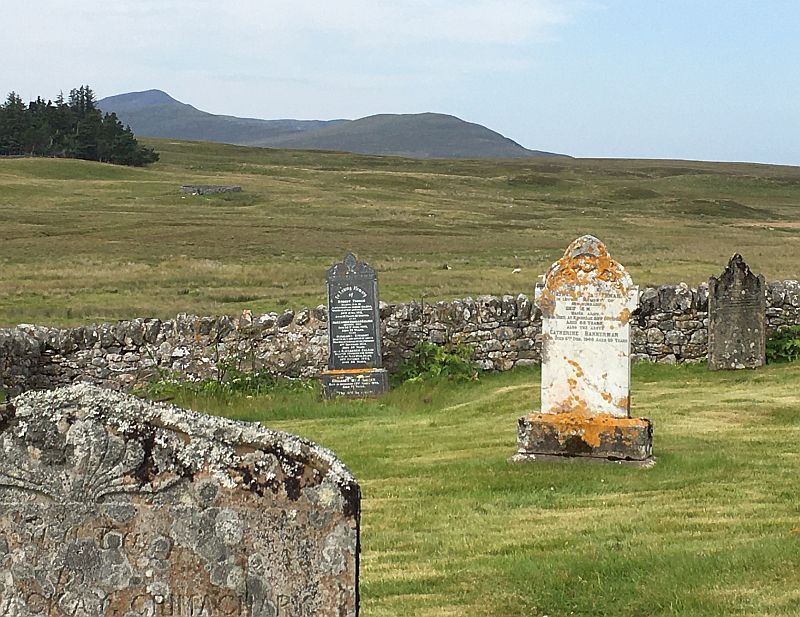
Ach’ na h-uai
In some trepidation lest I miss it, I kept a close eye on the hillside above the road and the map, ‘just before the start of Loch Achnamoine’ (I wasn’t driving). (We seem to have missed the Clearances Trail marker post though.) The ruins of the mission house and churchyard at Ach’ na h-uai.
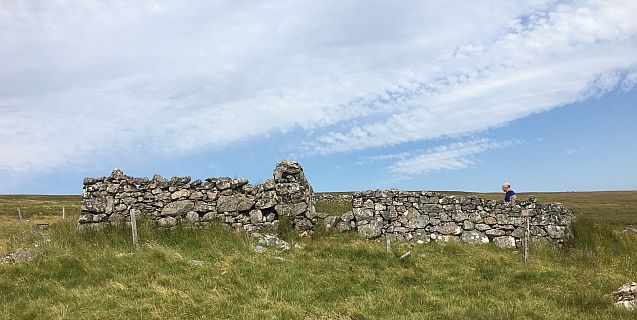
Perhaps due to its current day remoteness, this site had really captured my interest. The Clearances Trail app says of it “The Achness mission covered a large area including the whole of Strathnaver and the upper parts of Kildonan and Farr” [parishes].
It seems to have had a minister from around 1767 – see this extract from Sutherland and the Reay Country (1897). The Rev Donald Sage, son of Alexander, was ordained missionary here in August 1816. Along with his parishioners, he was turned out of his house during the Clearances.
The ruin is about nine miles from the parish church of Kildonan, a long Sabbath day journey, and even further from Farr parish church so it’s easy to see why it would have been built. A check of the earliest Ordnance Survey maps show the road, such as it was, going above this ruin rather than on the loch side which probably explains the setting.

The graves are those of shepherds who came to tend the sheep, Chisholms and a Gordon.
Return visit
There are several other sites to visit, including the gold rush information point at Baile an Or. It was comparatively busy, possibly due to a spot for swimming in the river, so I gave it a miss in these pandemic days. Not as busy as in the heady days of 1869 I’m sure.
I’m sure I’ll go back for there is more to see and I have a tenuous link: William Mckay was born in Kildonan parish on 13 January 1805 and married Jessie Sutherland in Walls, Orkney, my one-place study area, in January 1834.
Under blue skies and in sunshine, I really enjoyed my long-awaited exploration of Kildonan. At the same time, there is a sadness for an unpeopled valley and the memories it holds.
Further reading
There are plenty of books about the Clearances and Professor Jim Hunter’s recommendations are as good a place as any to start. Or check this website by Peter Lawrie.

Loved this blog. My husbands ancestor came from Kildonan and was a soldier who died at the start of the Battle of New Orleans. His widow and 3 children were one family who I suspect were cleared from Kildonan and ended up in Dunfermline, Fife. The 3 sons were born in Kildonan prior to 1805 and were found in Dunfermline during my family research. The widow died from burning when the sons were adults.
So pleased that you liked my blog and thanks for taking the time to comment. Kildonan is a lovely area.
Thank you for this blog. I am a director of Helmsdale Station CIC, a not for profit venture which lets the station building at Helmsdale as holiday accommodation with any trading surplus going to community causes and promoting travel on the Far North Line (between Inverness and the north coast) and other sustainable transport options. We have links with local providers of both folding bikes (for the train) and e-bikes for which a journey up the quiet Kildonan strath road is an ideal trip. We would like to recommend your blog to station house residents to entice them to make this memorable journey.
Hi and thanks for your comment. I'm happy for you to recommend this blog post to station house residents. Pleased to learn about what you are doing, I'll bear the accommodation in mind for future reference.
I very much enjoyed your blog. I am a descendant of the Selkirk settlers who left in 1813 they were McBeaths and Sutherland's. I hope to make a trip to visit in the future.
Hi and thanks for taking the time to comment, it's much appreciated. I do hope you will be able to visit, it really is a lovely area. I have a Mackay x3 great grandmother from Sutherland, very likely a cleared family too but from further north around Bettyhill maybe.
Nice read and interesting that another commenter Margaret and I have the same distant grandfather Neil Macbeth
Glad you enjoyed it and that you've spotted a distant relative. Thanks for taking the time to comment.
And interesting read. My ancesters were crofters in Kildonan
Thanks Sue. I don't think I have any ancestors from Kildonan though I do have a x3 great grandmother Ann Mackay whose origins are unclear. It is a lovely valley that should be properly inhabited.
I very much enjoyed reading your Blog as it brought back happy memories of a visit a few years ago to Kildonan – Kinbrace. My Grandfather Donald Bruce was born in Helmsdale in 1888 – I remember him well. I am now researching further back and my 2nd Great Grandfather was Donald Bruce born Kildonan in 1812. Your article has encouraged me to find out more so thank you very much!
Hi and thanks for your comments. Kildonan is a lovely place. Such a shame is it so unpopulated.
I was brought up in Helmsdale. My mother was an Innes, her mother a Sutherland. She met my father during the war , he was in the RAF early warning radar stations, Golspie/ Brora I think. I've been up the Strath many times, one of the most beautiful areas on this planet. Sometimes I read what is going on in the highlands via Helmsdale.org . Both my parents are buried in Helmsdale . A nice post thanks.
Thanks for reading my post and taking the time to comment. It really is a lovely area.
Lovely to keep these people in our memories. Love your blog xx
My relatives are Donald ‘Mor’ Sutherland and Rosanna Gordon. Donald stayed in Doll, Sutherland after the clearances but in his later years was back in Kildonan as a gamekeeper . .They are buried in the Kildonan Church Graveyard at the Manse .
Thanks. Glad you enjoyed the blog. I was back in Kildonan last week, such a lovely place.
My great grandfather David Gunn was born in Kildonan (1874 -1939) as was his father Kenneth Sutherland Gunn (1839-1900) and his father William Gunn(1787-1877). They were crofters. Great to hear of your journey band see read about the history.
Thanks for commenting. I'm really interested to know that there were families who managed to hang on for a few generations. It's a lovely area.